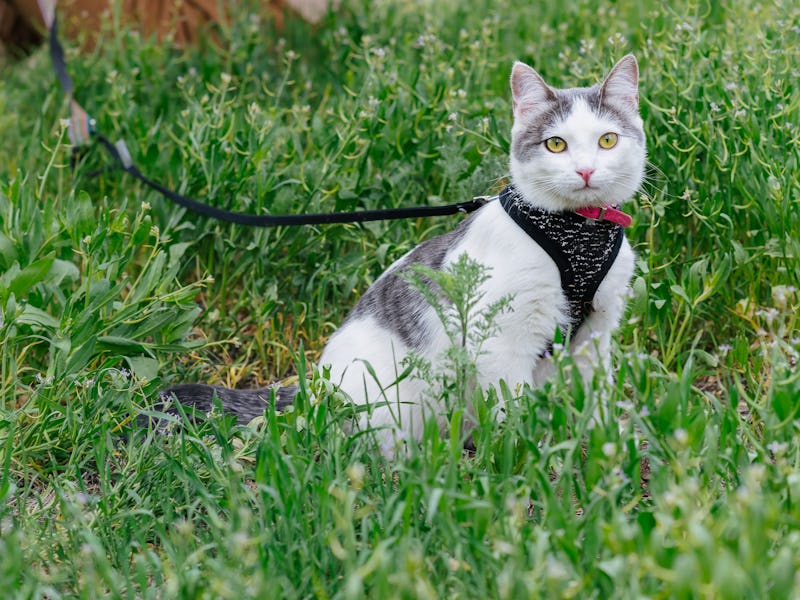
Choosing a cat over a dog as a pet frees you from mandatory daily walks. But just because your cat doesn’t need to go on a walk does that mean it shouldn’t? Cat experts say that’s far from the truth. Your feline companions can learn to walk on a leash far into adulthood — and the practice has numerous benefits to your cat’s wellbeing.
Forget about the distance
Taking your cat outside doesn’t have to involve a long stroll or even a walk around the block. Outdoor time for your cat is more mental than physical exercise. “Walking a cat is not like walking a dog,” Mikel Delgado, a cat behavior consultant in Sacramento, tells Inverse. “It's not like you're going to get your Fitbit steps in.”
For Delgado’s 14-year-old cat, Clarabelle, whom she trained to walk outside, the backyard was enough. “She would just … flop around in the dirt and roll around in the grass,” Delgado says. “It was great enrichment for her.”
Many experts recommend indoor cats get physical and mental stimulation, and research backs this up. A 2002 paper in the Journal of the American Veterinary Medical Association found that monotonous environments stressed cats out. This stress even made them vomit, have diarrhea, and pee outside their litter box. Cats deprived of activity might become bored and anxious, which can lead to undesirable behaviors like acting out or self-destructive habits like over-grooming.
Get a harness and take baby steps
If you do choose to take your cat on a walk, harnesses are non-negotiable, Delgado says. Harnesses are far better than collars, which aren’t safe, secure, or comfortable for kitties. Most cats, including older ones, can be trained to use a collar. For example, Delgado trained her 14-year-old cat, Clarabelle, to use a harness.
Cats can get scared easily, too, and are known to run at the first perceived threat. An open space far from your home will up your chances of losing your cat if they run away, so Delgado says it's best to try this new activity out in a familiar place. “We know that lost cats are much safer when they're close to home,” she says, noting they’re more likely to stay in that area.
As you both learn this skill, let your cat’s sense of comfort lead the process. “You can't just put a harness on a cat and expect them to like it or have any understanding that this is going to be associated with … going outdoors,” Delgado says. She advises you to start by simply draping a loose harness over your cat’s body and immediately giving treats. Once it’s unbothered by this foreign object, which could take days, fasten some straps or attach a limp leash, doling out treats and praise all the while. Take baby steps, prioritizing your cat’s safety and familiarity.
Also key for Delgado was sticking to appropriate activities Clarabelle could handle. “I wasn't trying to force her to do anything that she wasn't comfortable with,” she says. “I wasn't trying to take her grocery shopping with me.” There’s a difference between a gentle, secure sit outside and a camping trip, the latter which Delgado classifies as “adventure cat” material “I generally don't recommend that people try to make their cat into an adventure cat,” she says, because those adventures simply aren’t for cats. Special cases include exceptionally confident felines, and even then she says they must be trained from a young age to rough it.
Respect your cat's limits
You may confront the hard truth that your cat just isn’t suited for even small amounts of outdoor time on a harness. Cats can learn to expand their universe, but they may not want to. They may never accept the harness, or be too skittish to handle the unpredictable universe. If “they're the kind of kitty that hides under the bed when you have guests, they're probably not a good candidate,” Delgado says.
But there are still ways to give them a dose of the outdoors. She recommends catios (cat patios), which can be as simple as a mesh screen installed in a window. Pet strollers, which will also take some getting used to, are another, more secure way for cats to enjoy the outside world.
As long as you have the time, patience, and treats, it seems worth trying to prepare your cat for a foray of some sort into the wider world.